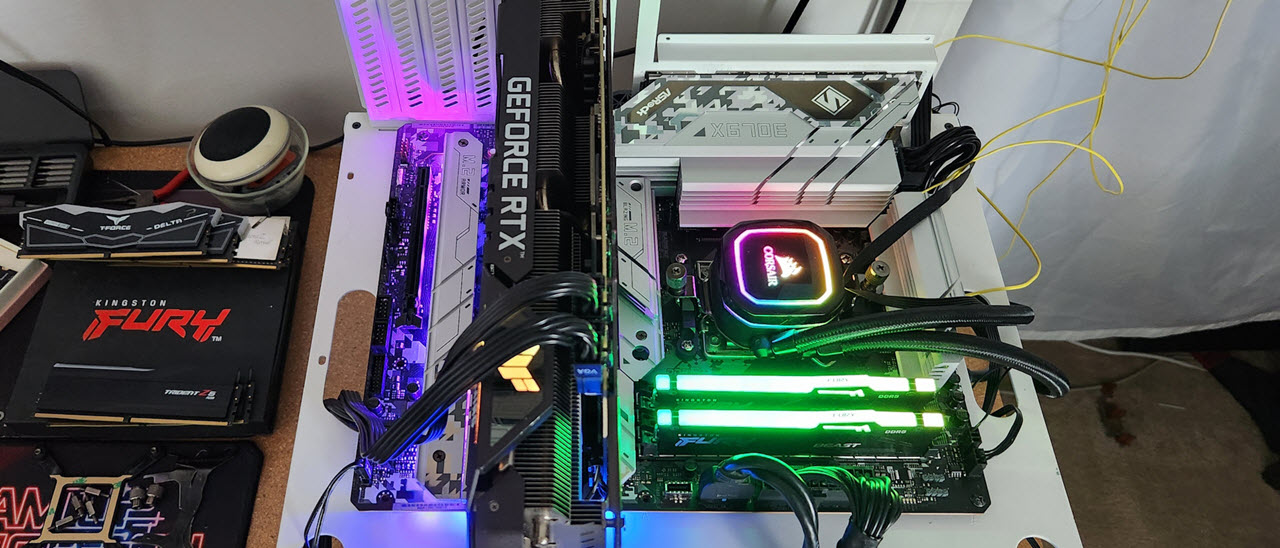Why you can trust Tom's Hardware
Our standard benchmarks and power tests are performed using the CPU’s stock frequencies (including any default boost/turbo), with all power-saving features enabled. We set optimized defaults in the BIOS and the memory by enabling the XMP profile. For this baseline testing, the Windows power scheme is set to Balanced (default), so the PC idles appropriately.
Synthetic Benchmarks
Synthetics provide a great way to determine how a board runs, as identical settings should produce similar performance results. Turbo boost wattage and advanced memory timings are places where motherboard makers can still optimize for either stability or performance, though, and those settings can impact some testing.
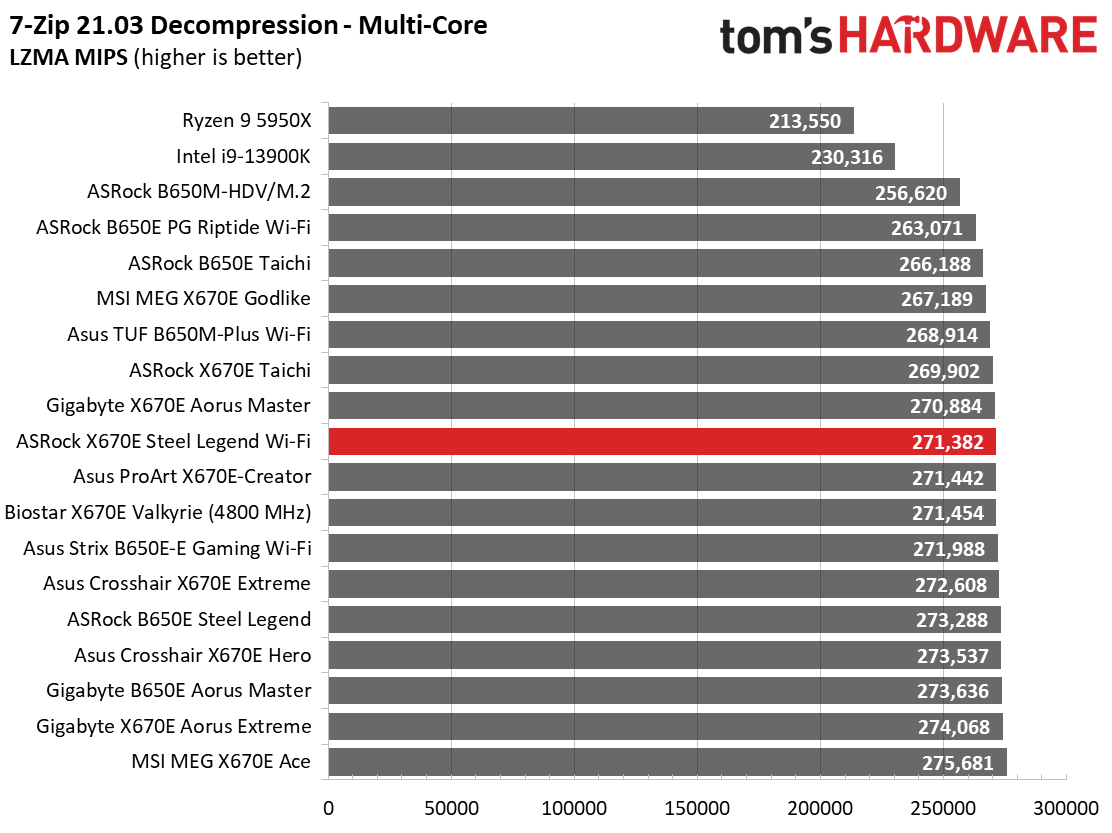
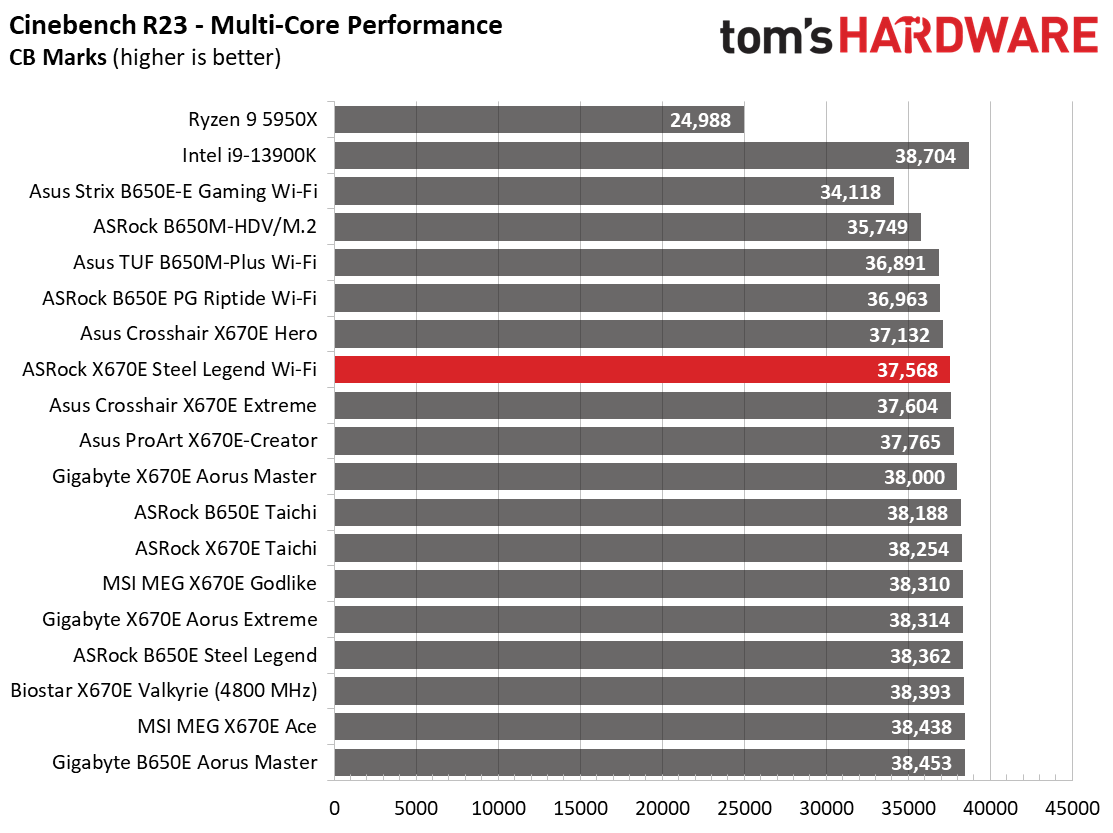
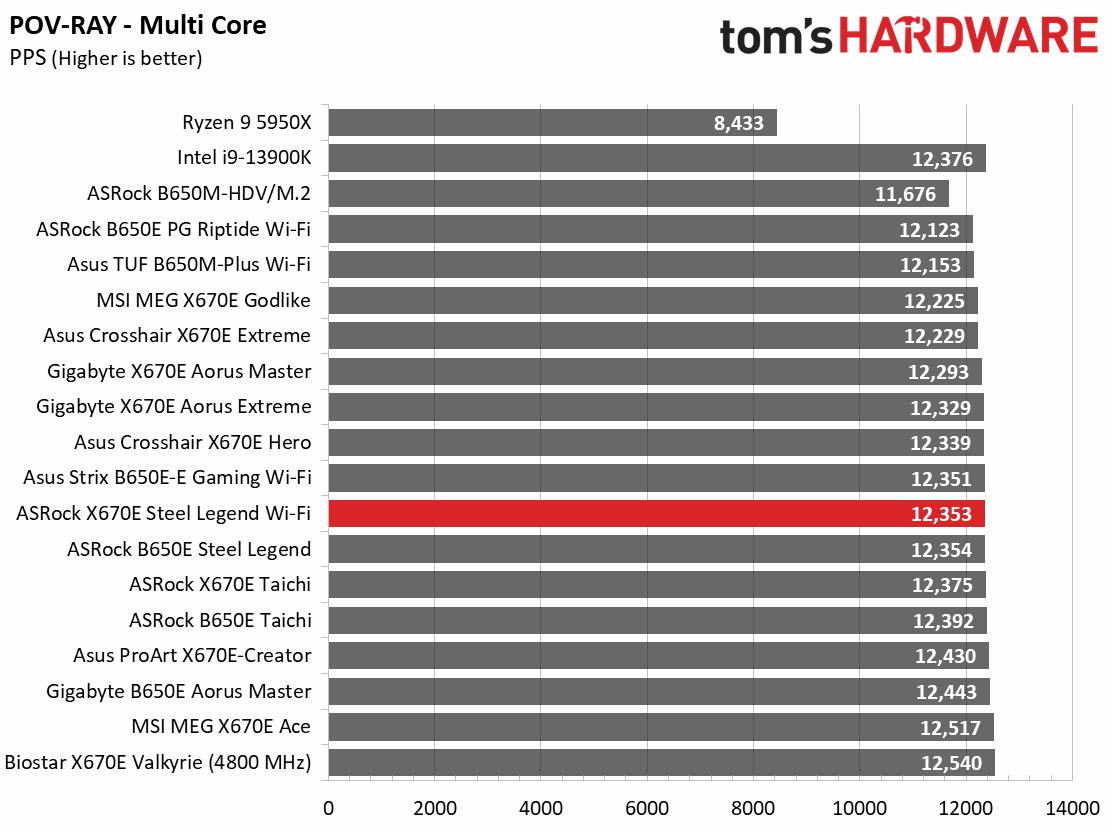
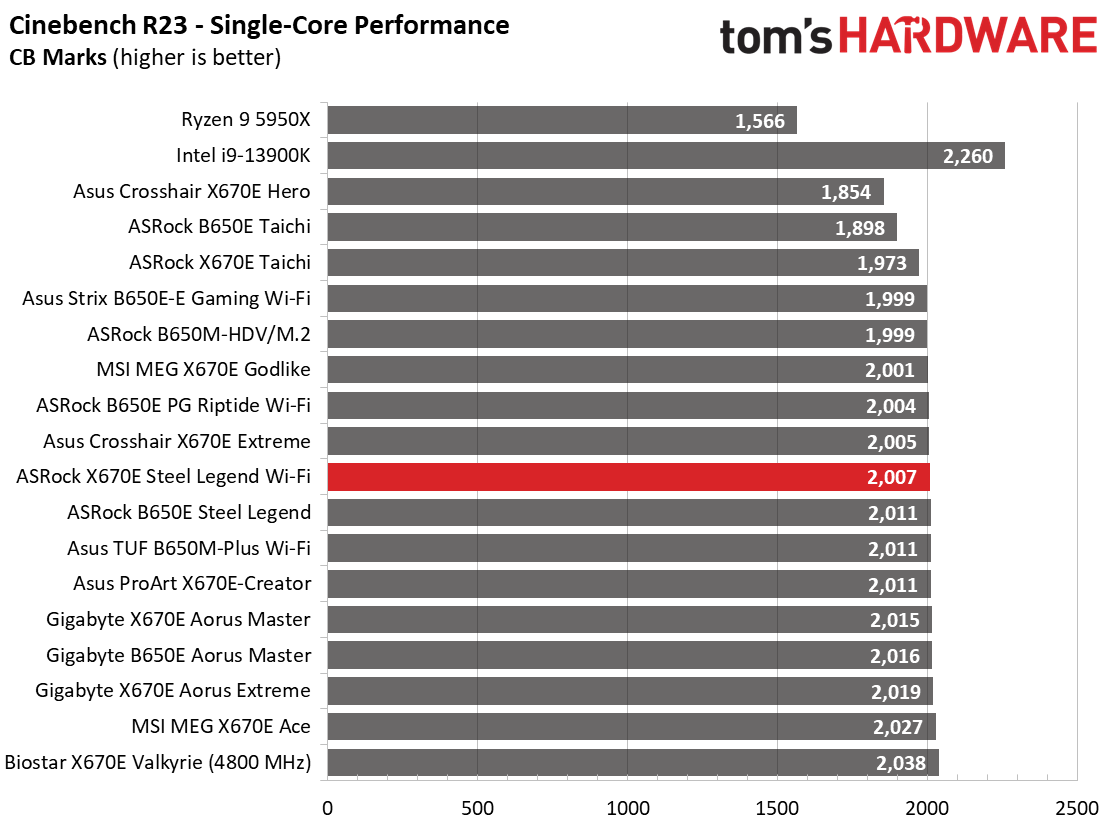
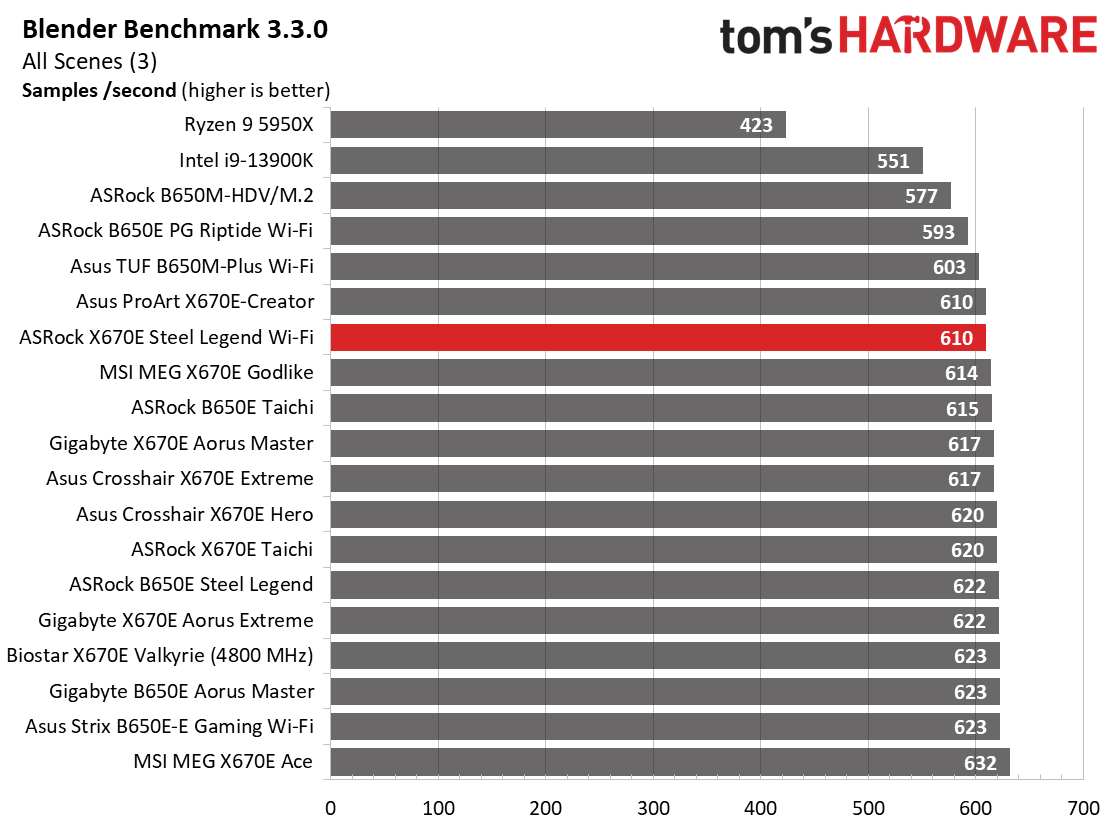

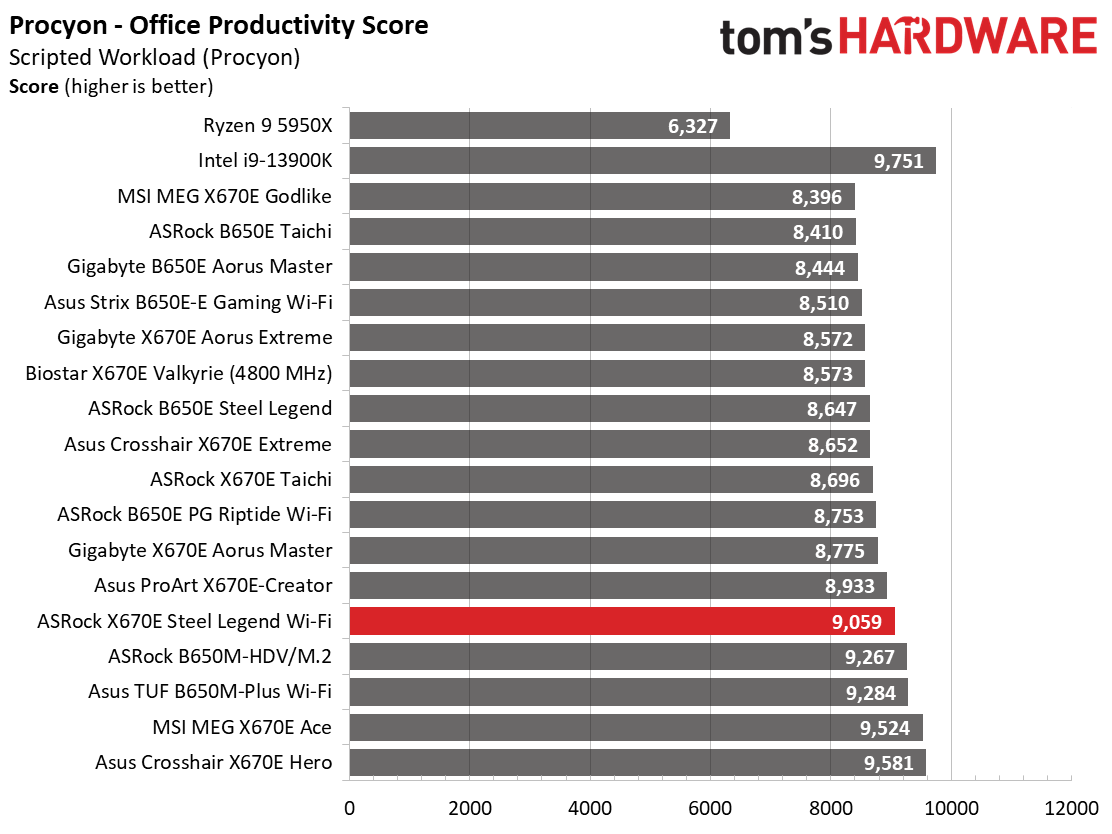
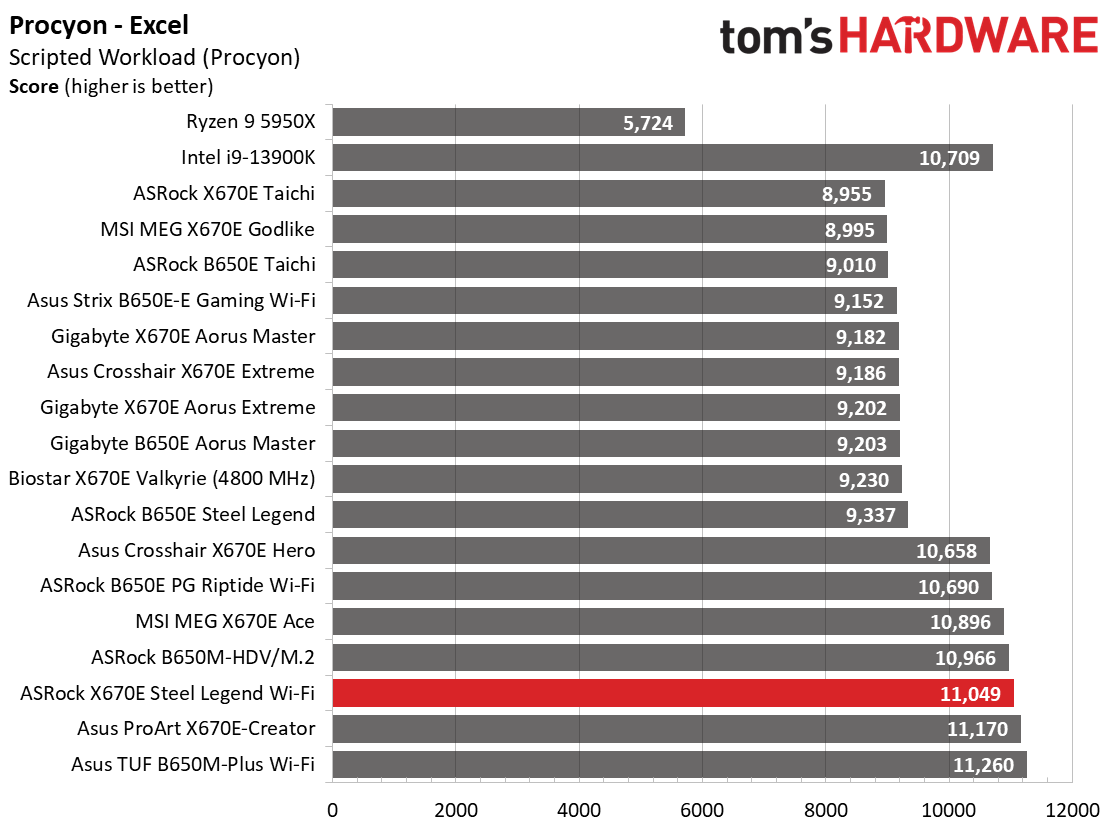
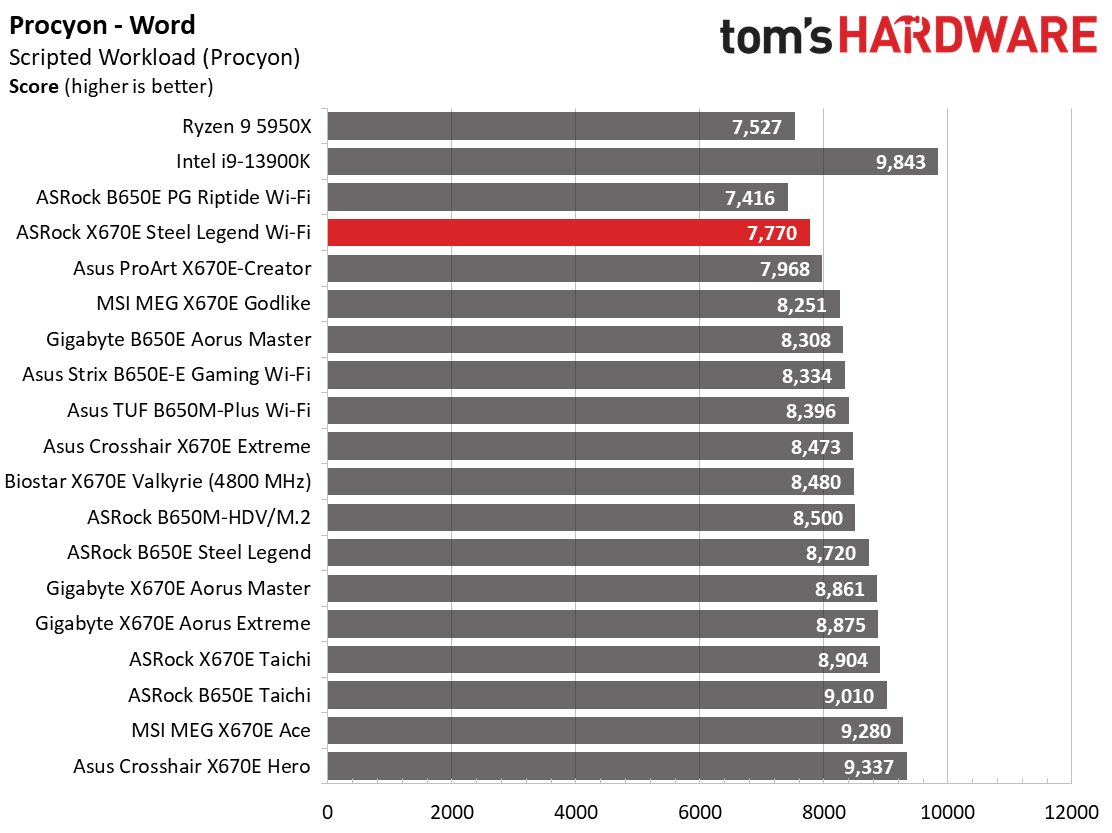
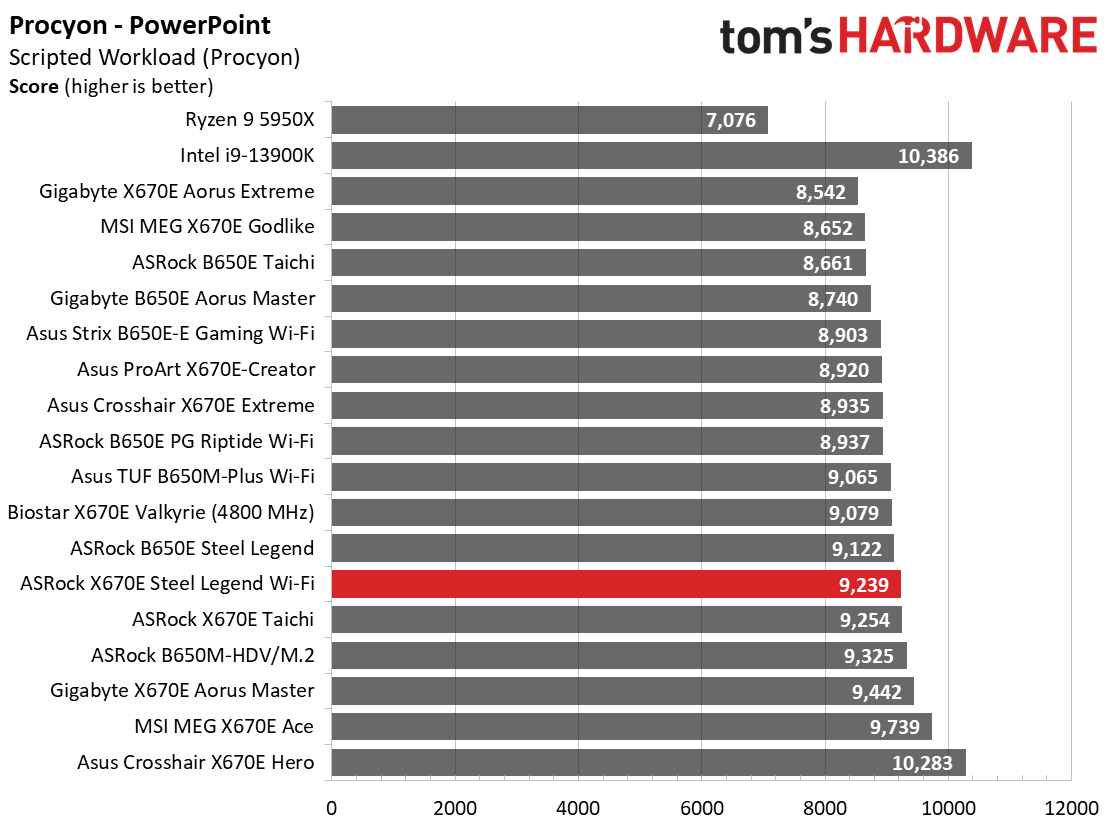
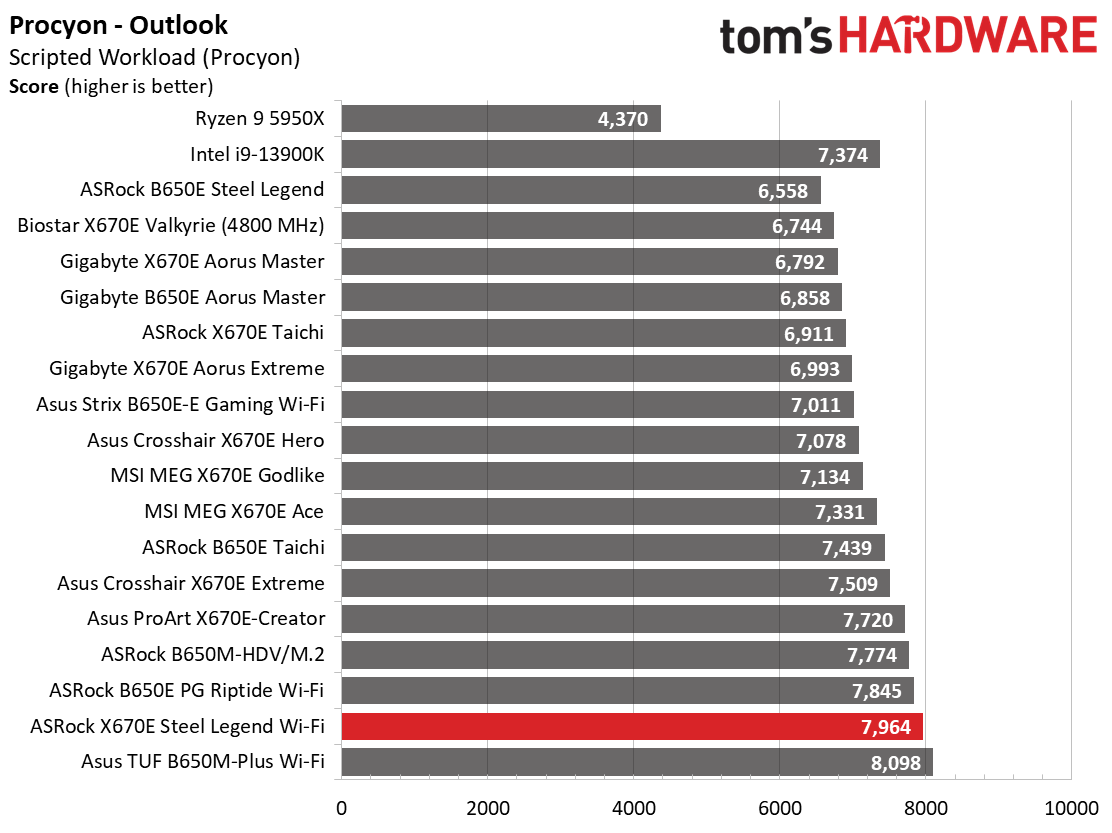

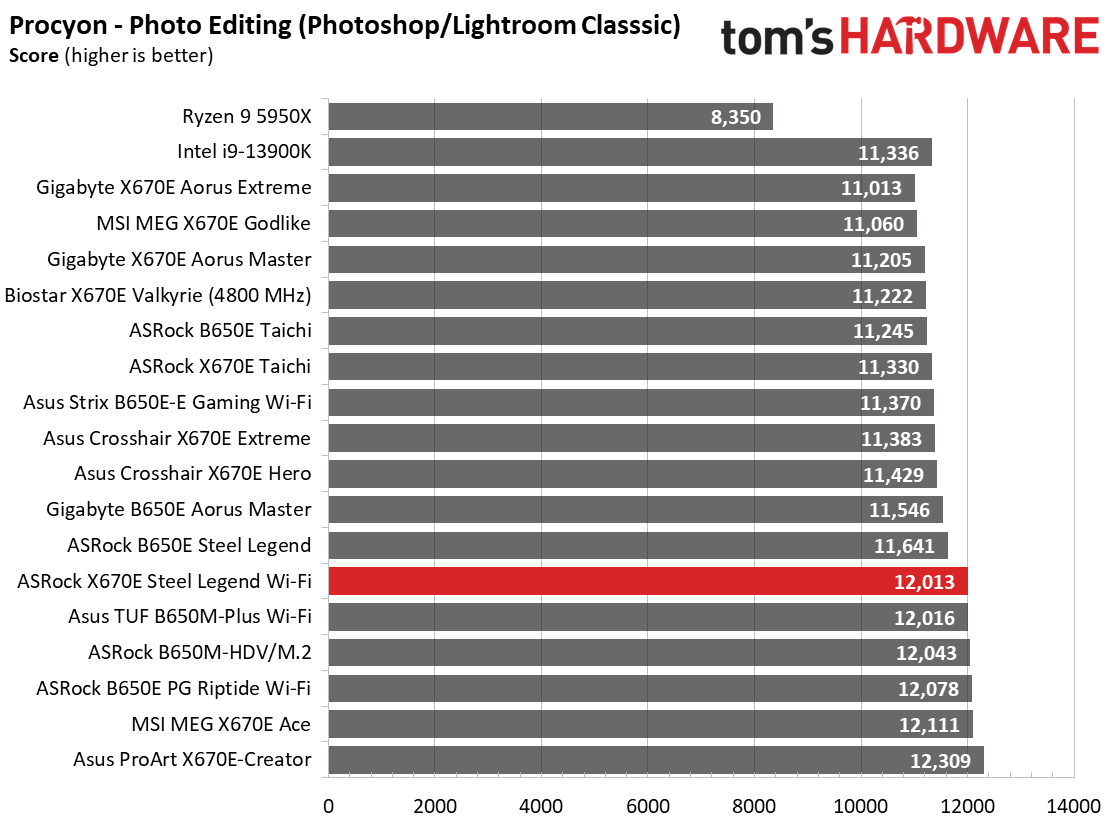
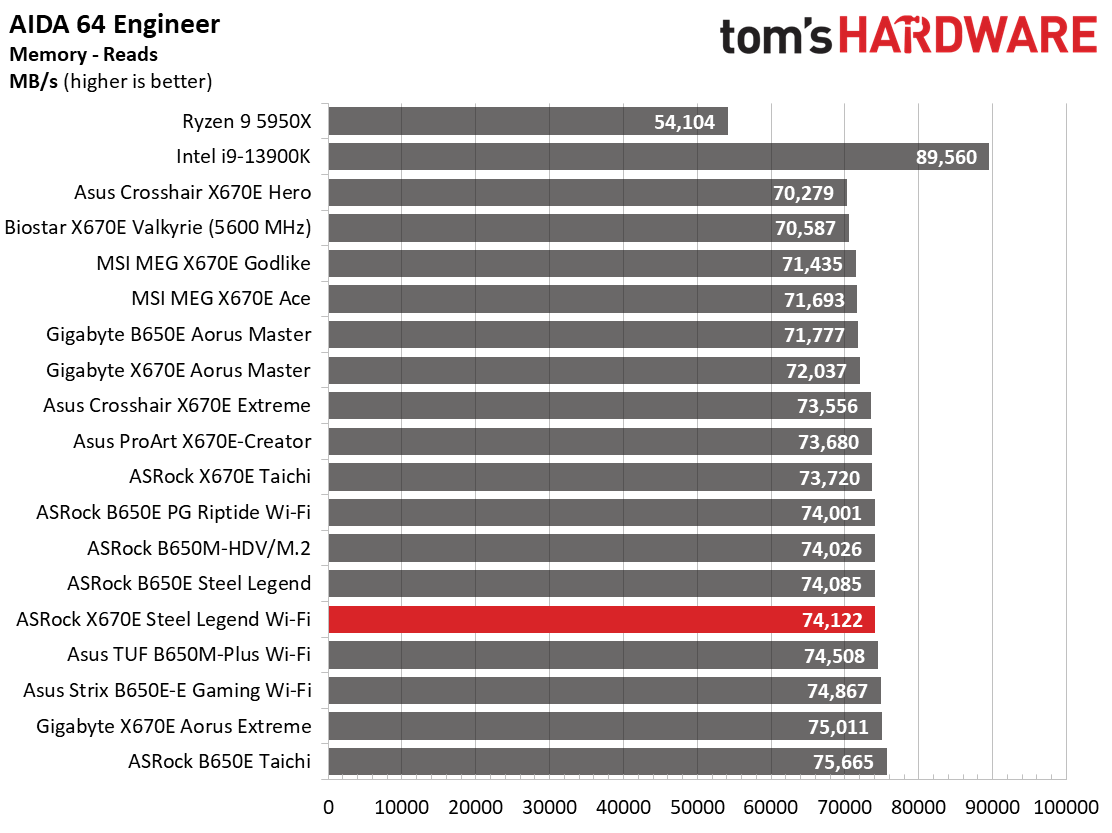
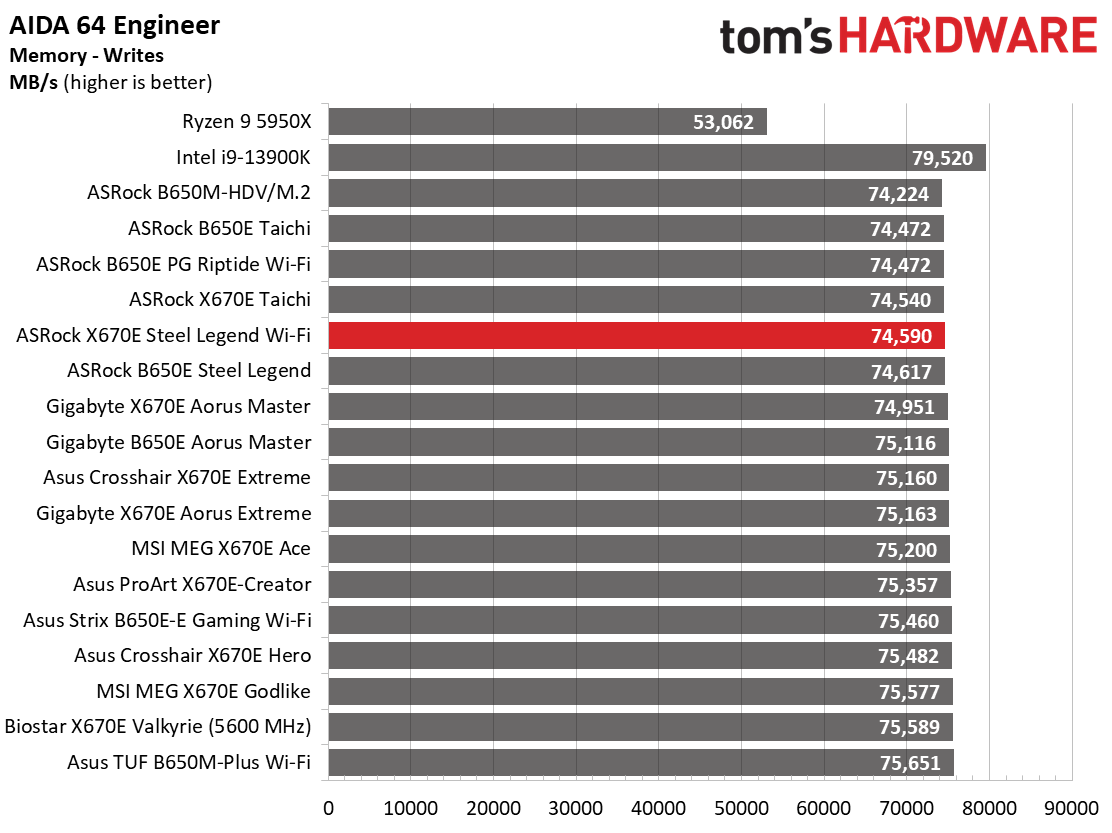
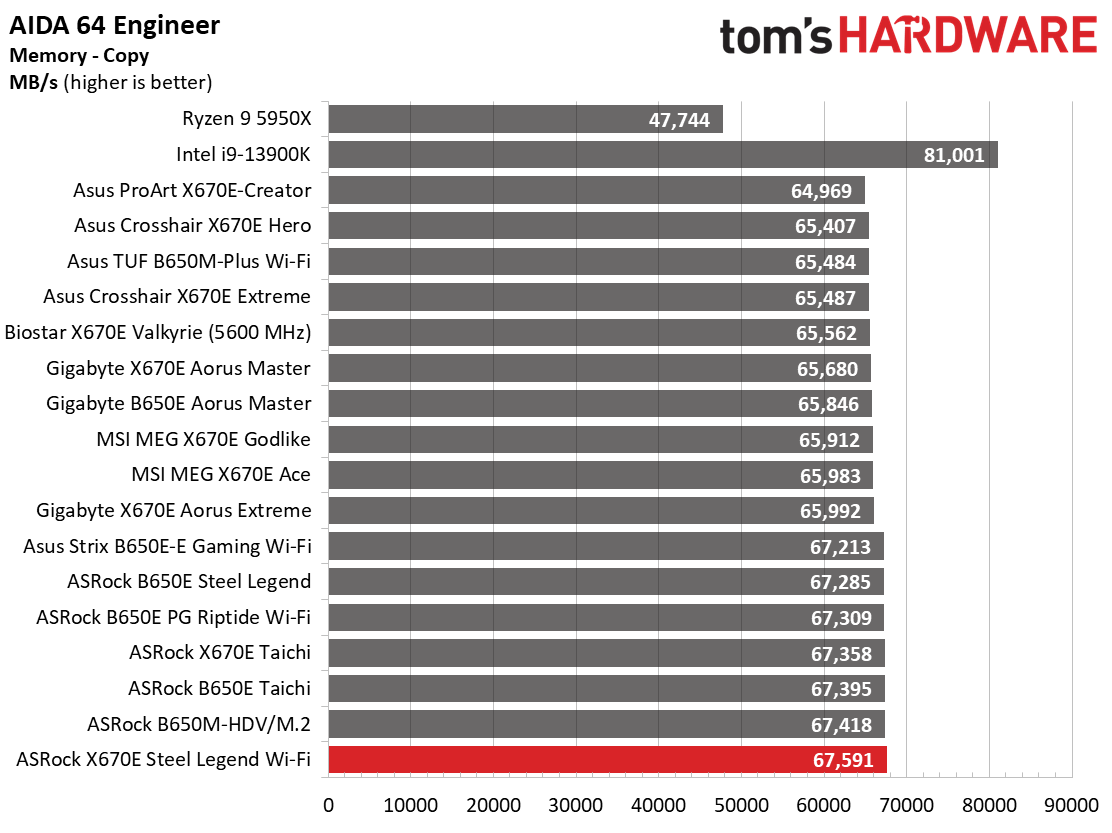
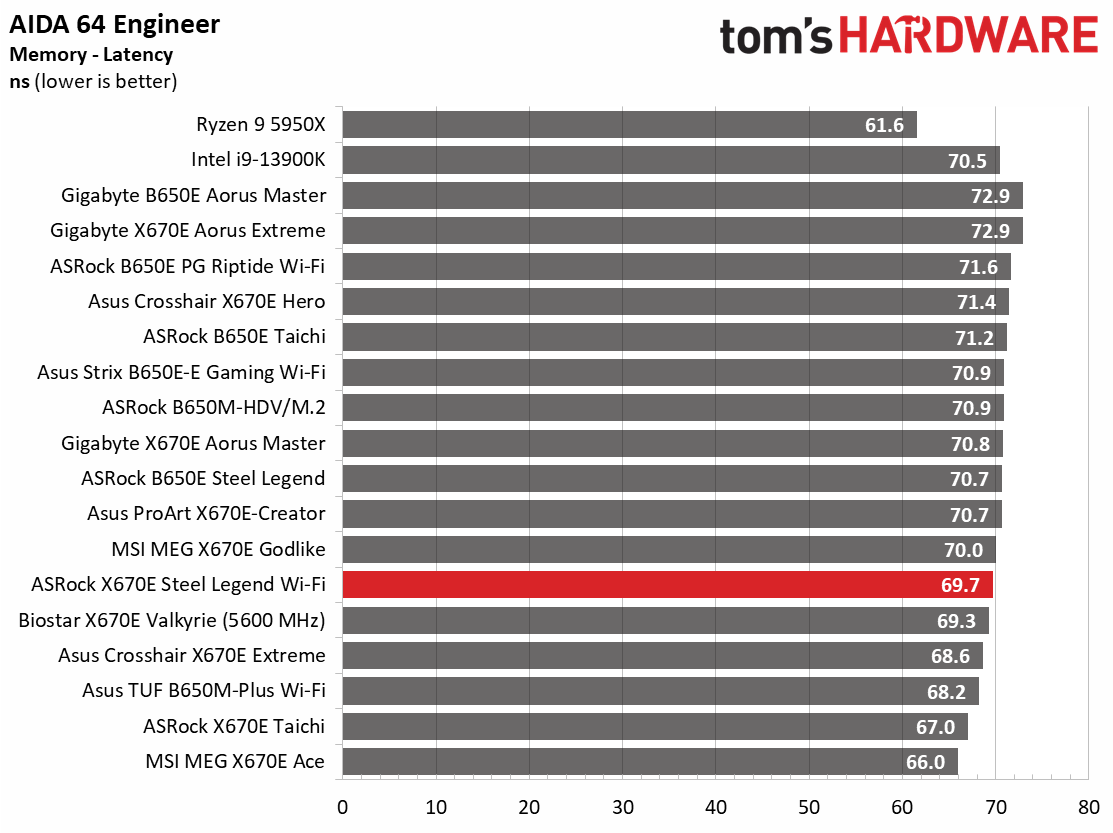
In our synthetic testing, the X670E Steel Legend performed well overall, achieving average to above-average results in most tests, just as the other Steel Legends before it. In this case, however, it did well in the Procyon suite. Performance is as it should be through these tests.
Timed Applications
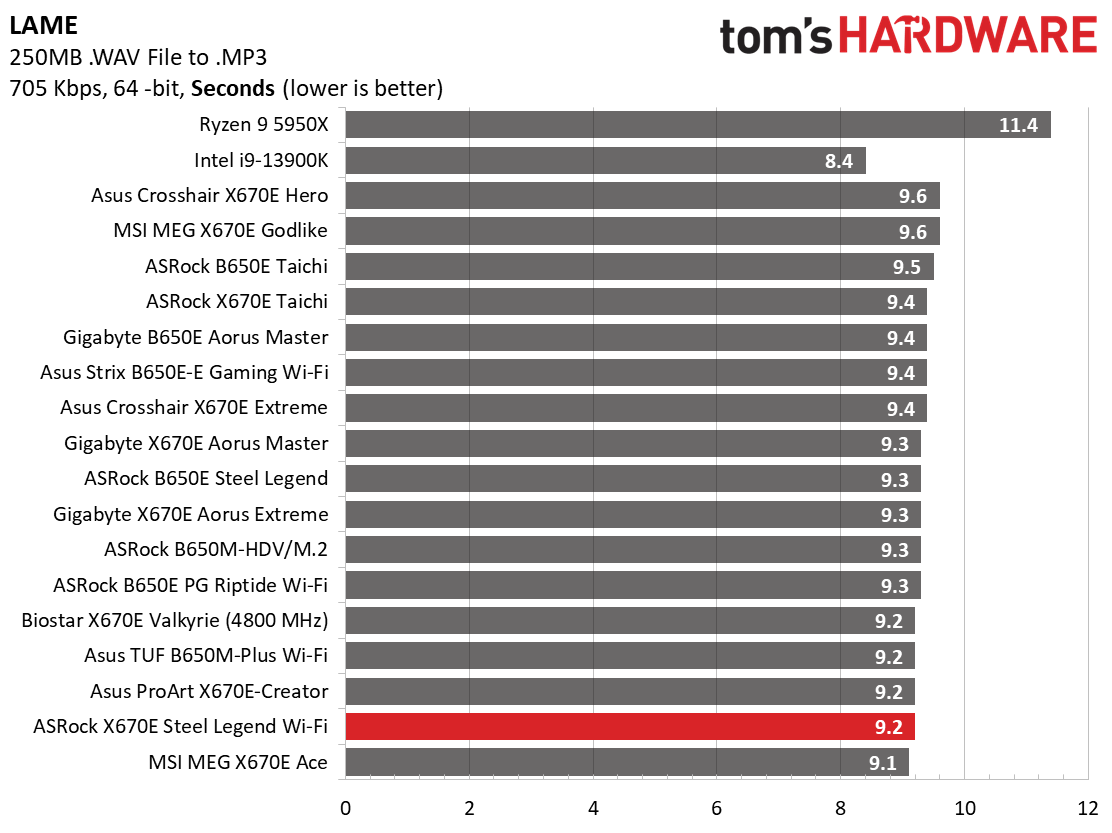
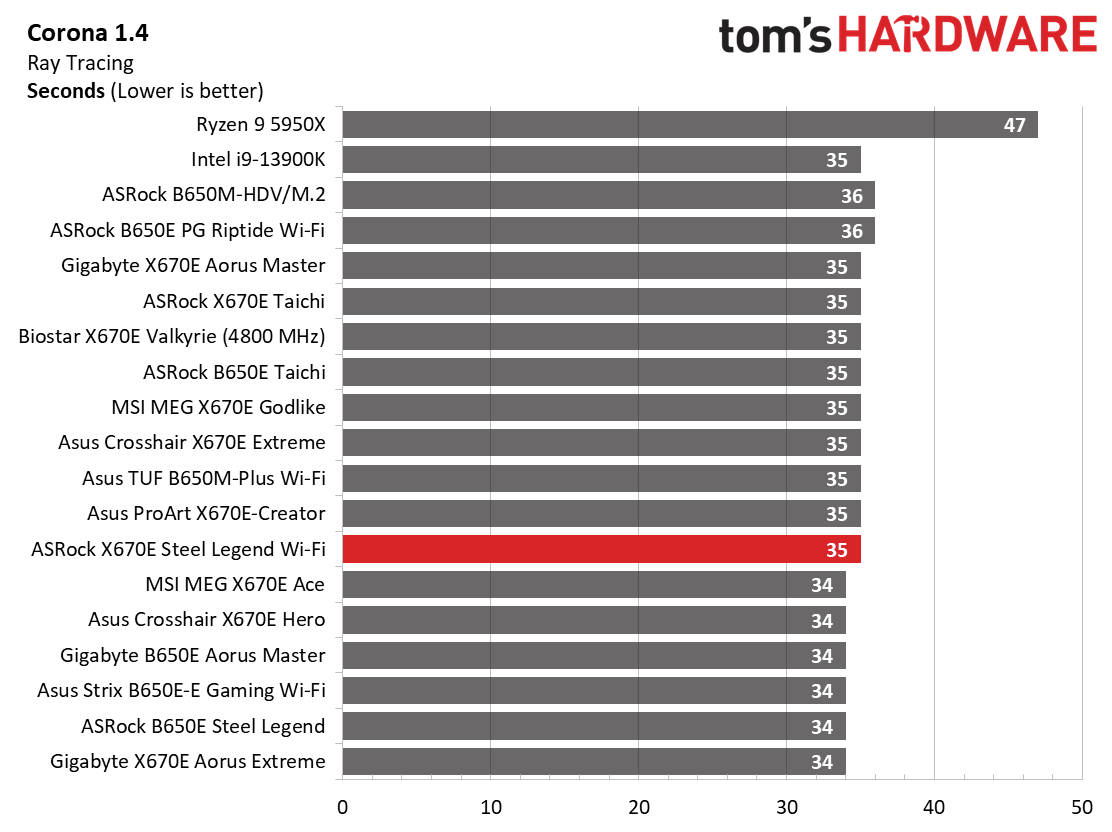
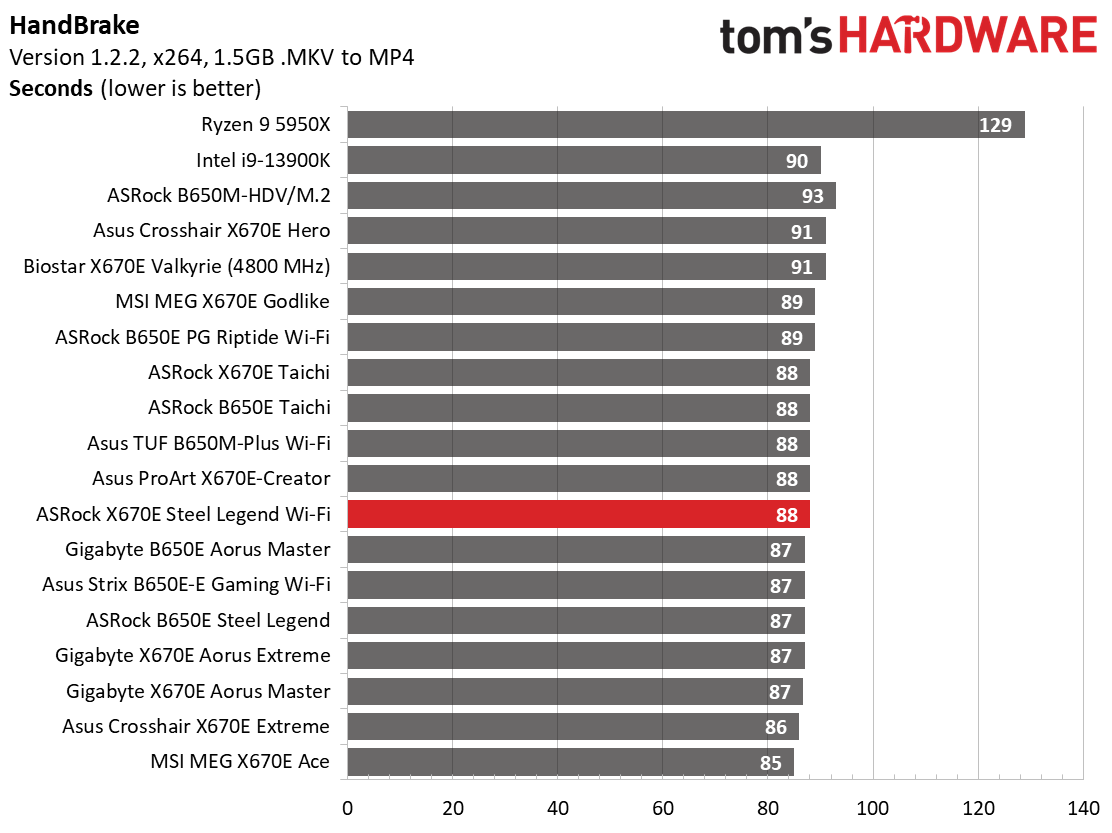
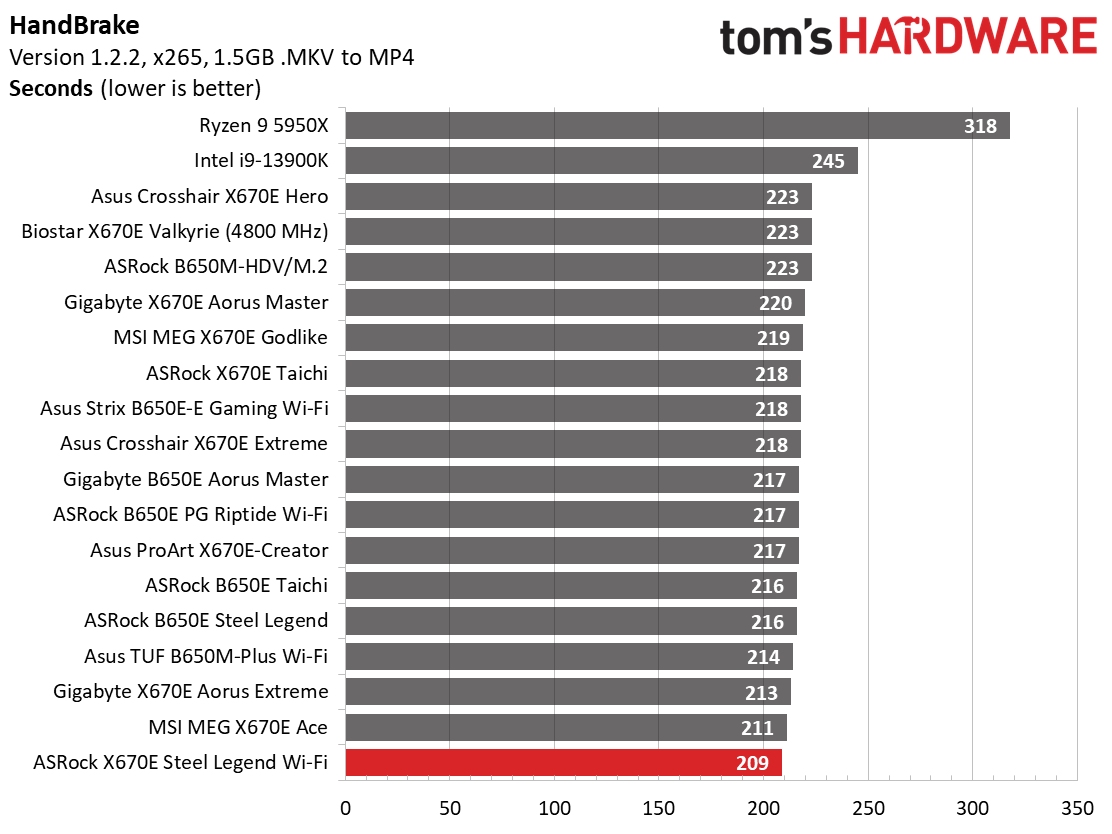
For the timed tests, this board managed to be one of the faster in LAME and average in Corona. Handbrake results were average in the x264 test, but the fastest we’ve tested in x265.
3D Games and 3DMark

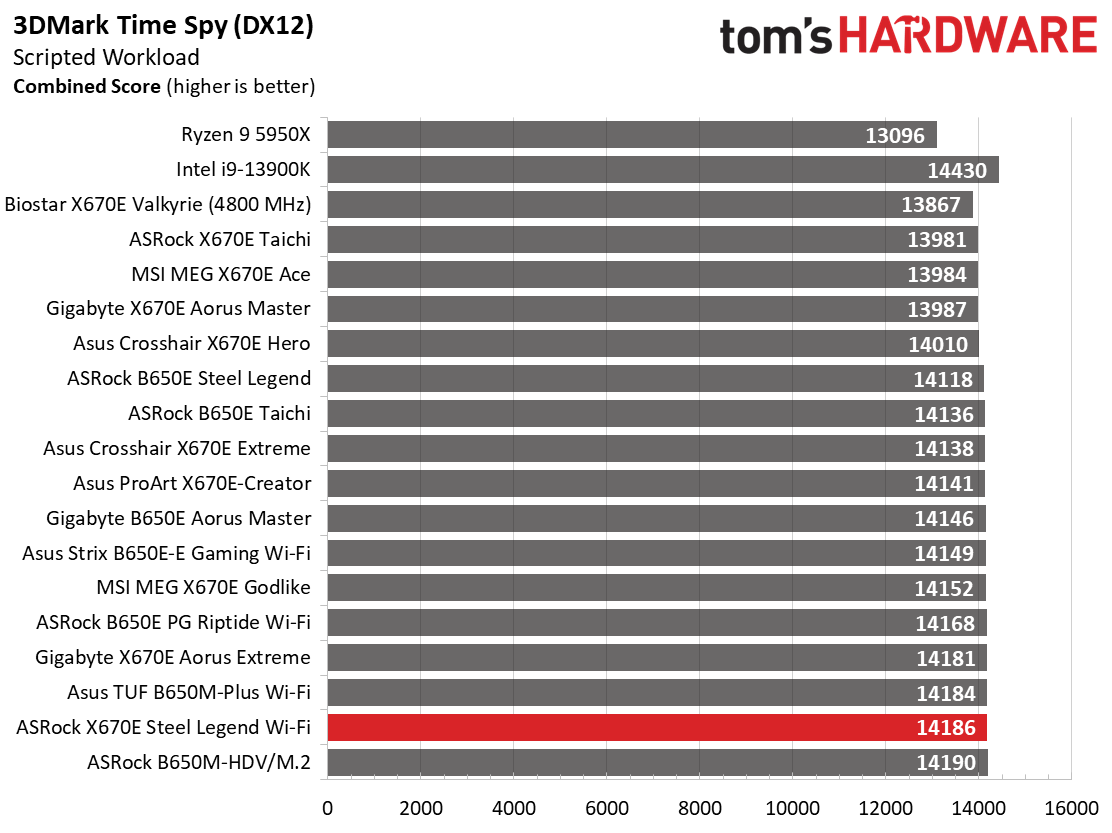
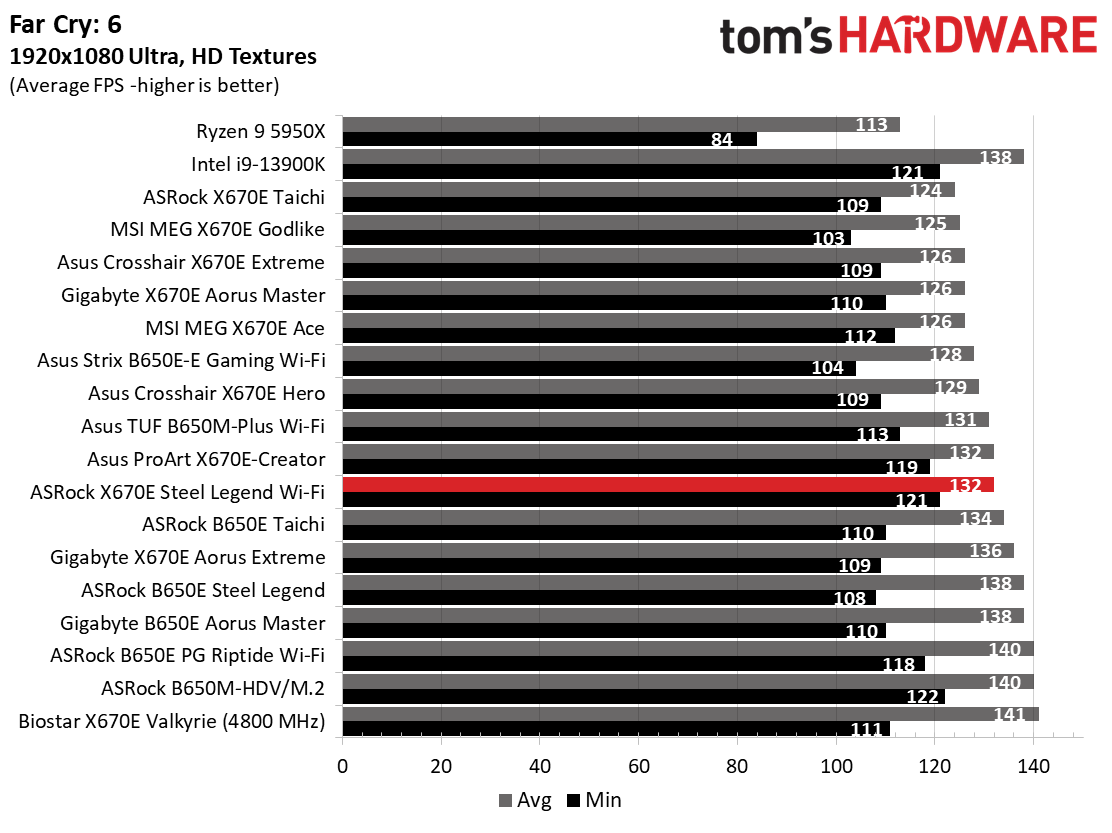
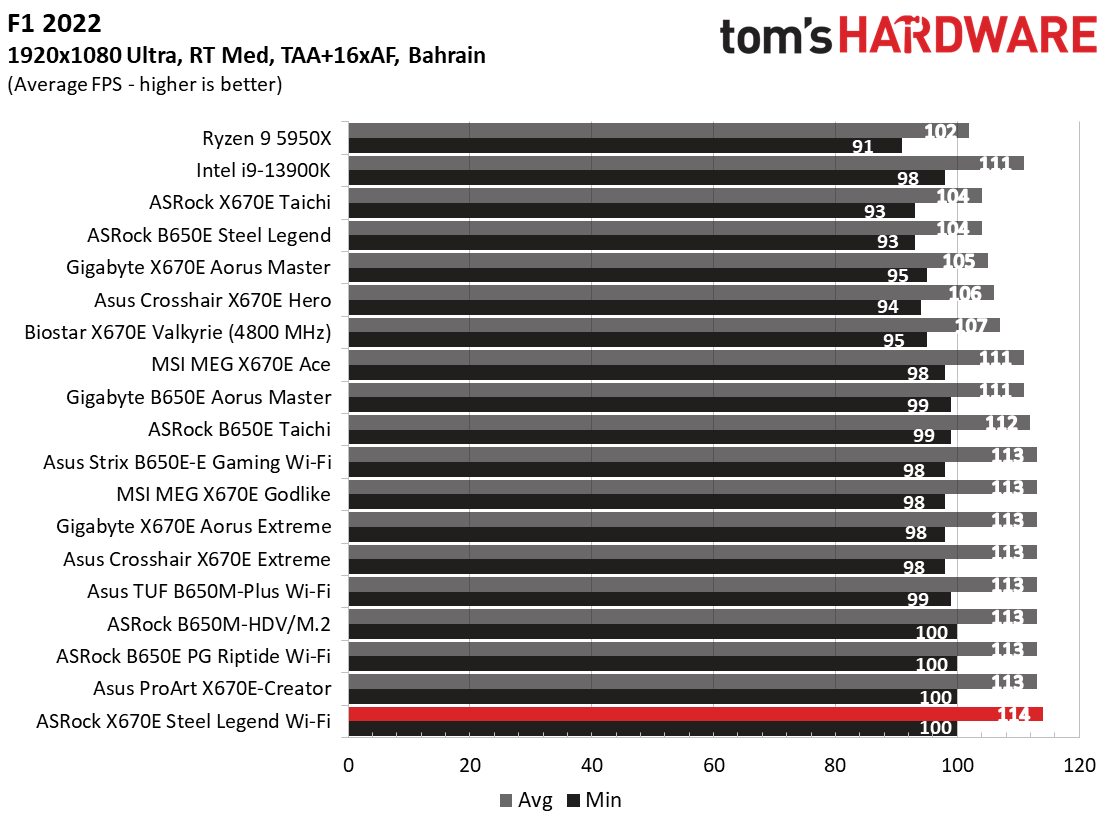
Starting with the launch of Zen 4, we’ve updated one of our games, F1 21 to F1 22, while keeping Far Cry 6. We run the games at 1920x1080 resolution using the Ultra preset (details listed above). As the resolution goes up, the CPU tends to have less impact. The goal with these settings is to determine if there are differences in performance at the most commonly used (and CPU/system bound) resolution with settings most people use or strive for (Ultra). We expect the difference between boards in these tests to be minor, with most falling within the margin of error differences. We’ve also added a minimum FPS value, which can affect your gameplay and immersion experience.
Finally, in our gaming tests, the X670E Steel Legend achieved solid results in the 3DMark tests and in games. In particular, it was the fastest we’ve tested in F1 2022. From our time with the board, we found it performant across various productivity testing and games, just like its peers.
Overclocking
Over the last few CPU generations, overclocking headroom has been shrinking (at least on the AMD side) while the out-of-box potential has increased. For overclockers, this means there’s less fun to have. For the average consumer, you’re getting the most out of the processor without manual tweaking. Our goal in this section is to increase the load on the VRMs and see if they can handle the additional stress. Overclocking AMD CPUs can be done in several ways (all-core or adjusted PBO values). But for simplicity’s sake, we just went with an all-core overclock of 5.4 GHz with 1.30V to increase the power output.
Get Tom's Hardware's best news and in-depth reviews, straight to your inbox.
Since our approach is to add power through all cores, we simply raised the CPU multiplier to 54x, manually set the voltage to 1.30V, and adjusted LLC to minimize vdroop. AMD states the sweet spot is around DDR5-6000 on the memory side, so we used the Kingston Fury kit, set the AMD EXPO profile, and checked for stability.
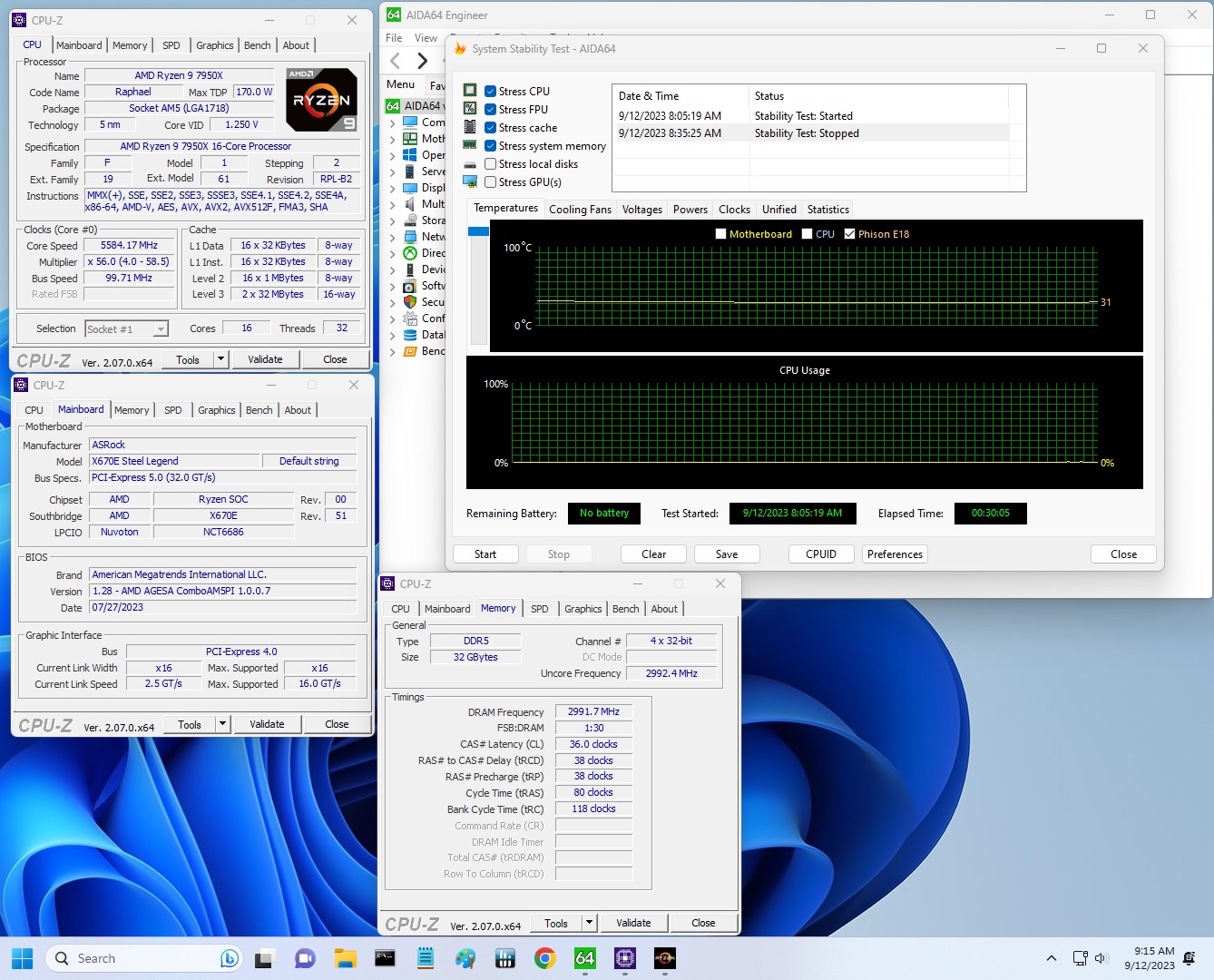
Overclocking on the X670E version of the Steel Legend was straightforward, as with most boards. Like others, we were able to set our voltage, adjust LLC to mitigate vdroop, and off we went on a 30-minute stable stress test. On the memory side, we dropped our Kingston Fury Beast DDR5-6000 kit into the system, enabled XMP, and tested it without issue, as expected (pictured above).
However, our Teamgroup DDR5-7200 kit didn’t want to play nice even though it was lower than the board's limit. As mentioned previously, that specific kit isn’t on their QVL list. To be certain, stick to the Memory QVL.
Power Consumption / VRM Temperatures
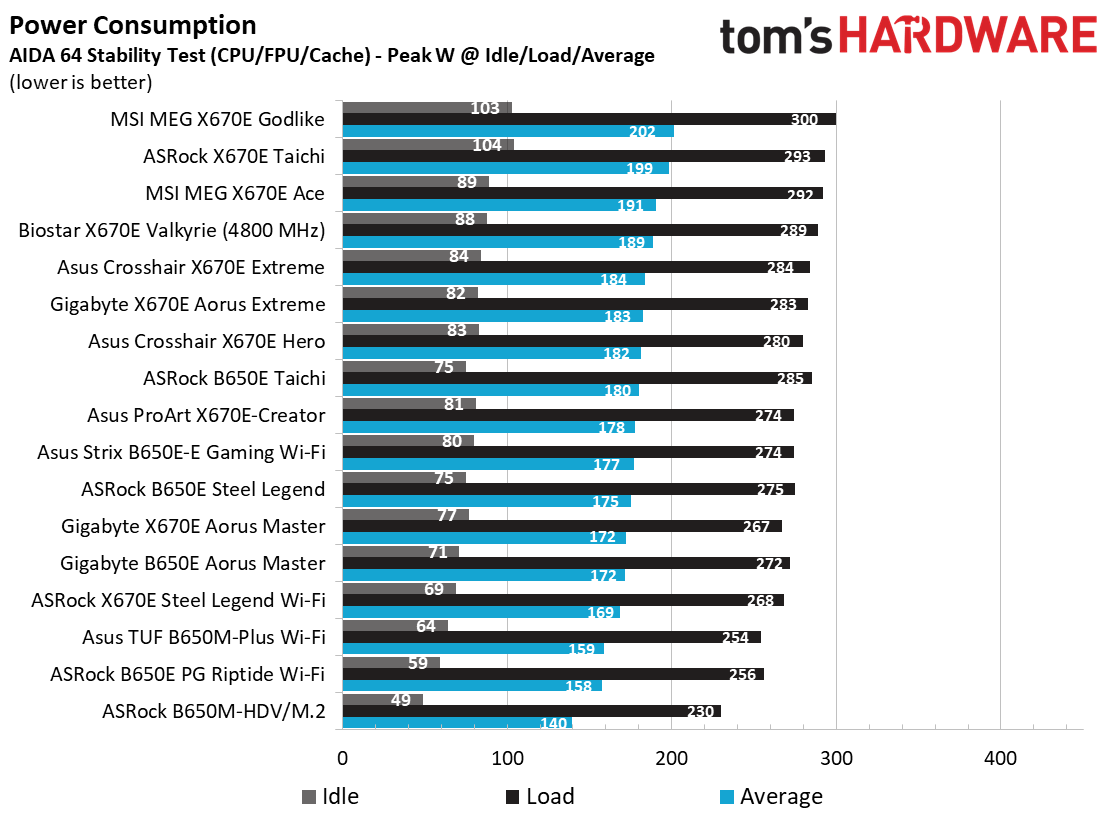
We used AIDA64’s System Stability Test with Stress CPU, FPU, Cache and Memory enabled for power testing, using the peak power consumption value. The wattage reading is from the wall via a Kill-A-Watt meter to capture the entire PC (minus the monitor). The only variable that changes is the motherboard; all other parts remain the same. Please note we moved to use only the stock power use/VRM temperature charts, as this section aims to ensure the power delivery can handle the chip even when overclocked. Since, generally, we’re using less power to get more clocks, those datasets are more novel than useful. We’re also temperature-limited on the processor, so adding more power isn’t possible without increased throttling.
Idle power consumption on our X670E Steel Legend and the Ryzen 9 7950X hit a low of 69W at the desktop/on idle. Load power peaked at only 268W at the wall, which both are on the efficient side of things for the X670 platform.




VRM temperatures on the X670E Steel Legend match other B650-based boards with similar VRM configurations. Temperatures peaked just over 50 degrees Celsius in our stress tests at stock settings and almost 60 degrees Celcius when overclocked. Both values are well within the specifications for the VRMs. You’ll be limited by CPU cooling before the motherboard/VRMs are the limiting factor.
Bottom Line
Overall, we like what the X670E Steel Legend brings to the table. Priced at $299.99, you get four M.2 sockets (including PCIe 5.0), dual NICs and integrated Wi-Fi 6E, a last-gen premium audio solution, and a neutral appearance that blends well with most build themes. For around $30 more than the B650E Steel Legend, that hardware yields an additional M.2 socket and dual NICs, plus faster and more abundant USB ports on the rear IO, and a better audio codec. This is a well-equipped motherboard for the price and could be worth the jump to X670E for the meager price increase.
There is plenty of competition around this price. The least expensive of the group is Gigabyte’s X670 Aorus Elite AX ($279.99). While it has the looks and price, it uses a dated audio codec. At $299.99, MSI’s MAG X670E Tomahawk also makes a case for itself but falls short on the rear IO USB count and speeds compared to the Steel Legend. Last, the Asus TUF Gaming X670E-Plus Wi-Fi ($329.99) is the most expensiv of this group, but only offers a slightly better audio codec. Of course, beauty is in the eye of the beholder, but only the Steel Legend has integrated RGBs out of these four.
Ultimately, ASRock’s X670E Steel Legend is a solid option in the budget X670/X670E space. During testing, we found the board to be performant across various tests. Whether it was productivity, daily tasks with MS Office, or gaming, the Steel Legend held its own throughout. As far as drawbacks, there aren’t many. The only one worth really mentioning is the lack of EZ latches on the M.2 sockets. That’s not a big deal, considering those parts aren’t changed frequently, but you will be fumbling with a few tiny screws if you occupy all the M.2 sockets on they board.
You could also say the board’s appearance isn’t special, but none are at this price point. If you’re in the market for a budget-class motherboard but need all of the features X670/X670E offers, ASRock’s Steel Legend should be on your shortlist for around $300.
MORE: Best Motherboards
MORE: How To Choose A Motherboard
MORE: All Motherboard Content

Joe Shields is a staff writer at Tom’s Hardware. He reviews motherboards and PC components.
-
Avro Arrow For the money, you can't beat ASRock this generation when it comes to motherboards because their X670E boards tend to be less expensive than the non-E versions of most other makers.Reply
On thing in the headline made me chuckle a bit:
"Budget X670E board" - The word "budget" should never be used in the same sentence as "X670E" when it comes to motherboards.
Then I saw this that was even funnier...
"ASRock describes the Steel Legend as a “philosophical state of rock-solid durability and irresistible aesthetics.” :??:
I don't know what they're smoking at ASRock but I think that the Steel Legend would be best described as... "a motherboard". :ROFLMAO: -
PEnns I am confused,Reply
Isn't this motherboard meant for AMD CPUs?? And yet the test is run using Intel Core i9-13900K....??
Or maybe my caffeine didn't kick in yet....;) -
bourgeoisdude I got this board a while back (when X670E were the only choices) because I never wanted to run out of USB ports again. For the price point I think it is the best X670E in the price range.Reply -
simonharris314 Reply
Not the first time this has happened (the problem with cutting and pasting). To be fair, on the last page it does mention the Ryzen 9 7950X.PEnns said:I am confused,
Isn't this motherboard meant for AMD CPUs?? And yet the test is run using Intel Core i9-13900K....??
Or maybe my caffeine didn't kick in yet....;)
Ooops. Mentioned it on the first page too!
That'll teach me to skim read. -
CerianK Under 'Specifications':Reply
(2) PCIe 4.0 x4 (64 Gbps) / PCIe (up to 80mm)
should read
(3) PCIe 4.0 x4 (64 Gbps) / PCIe (up to 80mm).
From ASRock site:
1 Blazing M.2(PCIe Gen5x4),
3 Hyper M.2 (PCIe Gen4x4), -
Giroro I wonder why PC sales are way down.Reply
Do you think it could be because "budget" motherboards cost $300? -
Geezer760 Since when is $300 for a MB considered Budget, this board dosen't even include a digital error code thing at $300 it should include that at the very least.Reply -
Hotrod2go Reply
More like mobile computing is increasing in popularity these days, so no need for desktop systems as much like in the past.Giroro said:I wonder why PC sales are way down.
Do you think it could be because "budget" motherboards cost $300? -
bourgeoisdude It's a "budget" X670E motherboard. Which isn't really a budget chipset, as that is the top tier. If you want budged AM5 look at the B650/B650E motherboards.Reply -
smitz314 Appreciate the detailed review. Well done.Reply
Our next (and potentially one of the last) AMD X670 reviews on our current review platform, is ASRock’s X670E Steel Legend Wi-Fi.
That's disappointing. There are several other X670 reviews I was hoping for, most notably for MSI boards.
Also, why delay the review of a product that was released 12 months ago? Seems odd.
